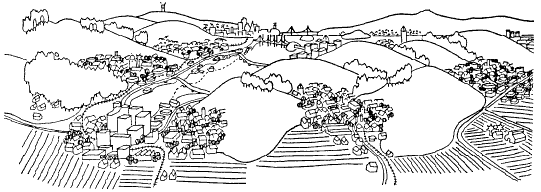The implementation would eliminate the following:
Laws force the providing of parking based on floor area, number of bedrooms (for apartment complexes) and tables (for restaurants). These laws force all consumers to pay higher prices to subsidize automombile transportation, and encourage greater auto usage. Studies have shown that transit usage would be tripled in many regions by eliminating laws that force the providing of parking.
Most low-density zoning is established solely for traffic mitigation purposes. Silicon Valley is an example, with the industrial area density at .35 FAR (Floor Area Ratio). This means that a six-story building is required to occupy land that is 18 times greater than that required for the building itself. The excess land can be legally used only for parking lots and landscaping. It eliminates efficient, compact development. It makes the area extremely difficult for transit to serve, increases distances (making it much harder for bicyclists and pedestrians), and takes up open space land. Considering the price of land, the excess land is also very expensive for the landowner. The land is wasted.
Another example of low density zoning is San Jose's prohibition of "granny" homes. While this law was made to minimize on-street parking, it damages transit and brings greater pressure to use open space land. It also exacerbates the severe housing shortage.
These are counter-productive because they encourage greater automobile usage. They are also unfair to non-car users, who must subsidize lane construction, interchanges, parking lots, etc.
These are very damaging to transit because:
The potential transit user is not given the free-market choice of either using this increase in cost to pay for automobile transportation, or to pay for transit. These costs are passed on to the development residents through higher rents (or purchase prices); and to employees working at the development through wages reduced from what the companies could pay if their facility costs were lower. Even if they prefer to use the money for transit, they still are forced to provide for automobiles, which compete with transit.
The potential transit user may never use transit to/from such development (either residential or industrial) because:
(a) the money he/she has earmarked for transit fares has instead gone to pay for the freeway, local roads and parking lots.(b) the competing automobile facilities are already in place. For example, the freeway's usage cost appears to be zero because he/she already paid for it (albeit against his/her free will).
(c) any transit service in such an area will be infrequent (more waiting) and spread thin (more walking). Moreover, because transit farebox revenue is proportional to the number of people taking transit, more subsidy will be required.

Open space does not harm transit. In the past, development often clustered around transit stations. Developers sometimes supplied guideway transit to their developments (including some in the East Bay and San Francisco). Unlike today, those developers were not required to put in roads and parking lots, and forced to spread out the buildings so that transit users could not walk to them from the station.
Without using more open space, existing development will gradually become transit-friendly as laws for automobile accommodation are repealed. These laws include FAR (Floor Area Ratio) limits, max. dwelling unit and similar low density zoning, mandated parking lots, and road construction (unless such construction is 100% user paid). Transit-friendly development neither takes public money, nor interferes with private property rights.

Sprawl harms transit. It is encouraged by automobile subsidies and enforced by government regulations.
Graphics courtesy of Greenbelt Alliance